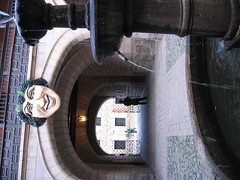The Casa de las monedas
14 December 2005
4:00 PM
We saw the silver mines and refineries in Potosí so it made sense to finish the cycle and visit the Casa de la moneda (the Royal Mint) too. Once the Spaniards started mining silver, they also wanted a nearby place where they could mint it. Thus the Royal Mint came to be. Today it is an interesting collection of artwork, artifacts, and the history of currency. They have the original machinery, powered by mules and humans, that were used to flatten silver into strips and stamp coins from them. They also have the steam-powered machines from Philadelphia and New Jersey that replaced the old ones.
The Mint also has a collection of old coins made there centuries ago. The oldest have uneven edges because it was the weight of the coin, not the shape, that mattered. It was an interesting reminder of the changes in currency over the ages. First currency had intrinsic value; the material from which it was made itself was valuable. Later the currency was backed by some valuable material in a remote location—the gold and silver standards of times not long past. Today in many places currency itself is practically worthless (the paper of a $100 bill isn’t worth much and it is backed only by the promise of payment. It’s a system that I must admit I don’t understand well.
In the Mint we also saw samples of raw minerals, silver statues, and the preserved skin of an ancient armadillo. Who knows what it was all doing there. It was overall very interesting, but it’s hard to beat exploding dynamite.


Comments